Paper Menu >>
Journal Menu >>
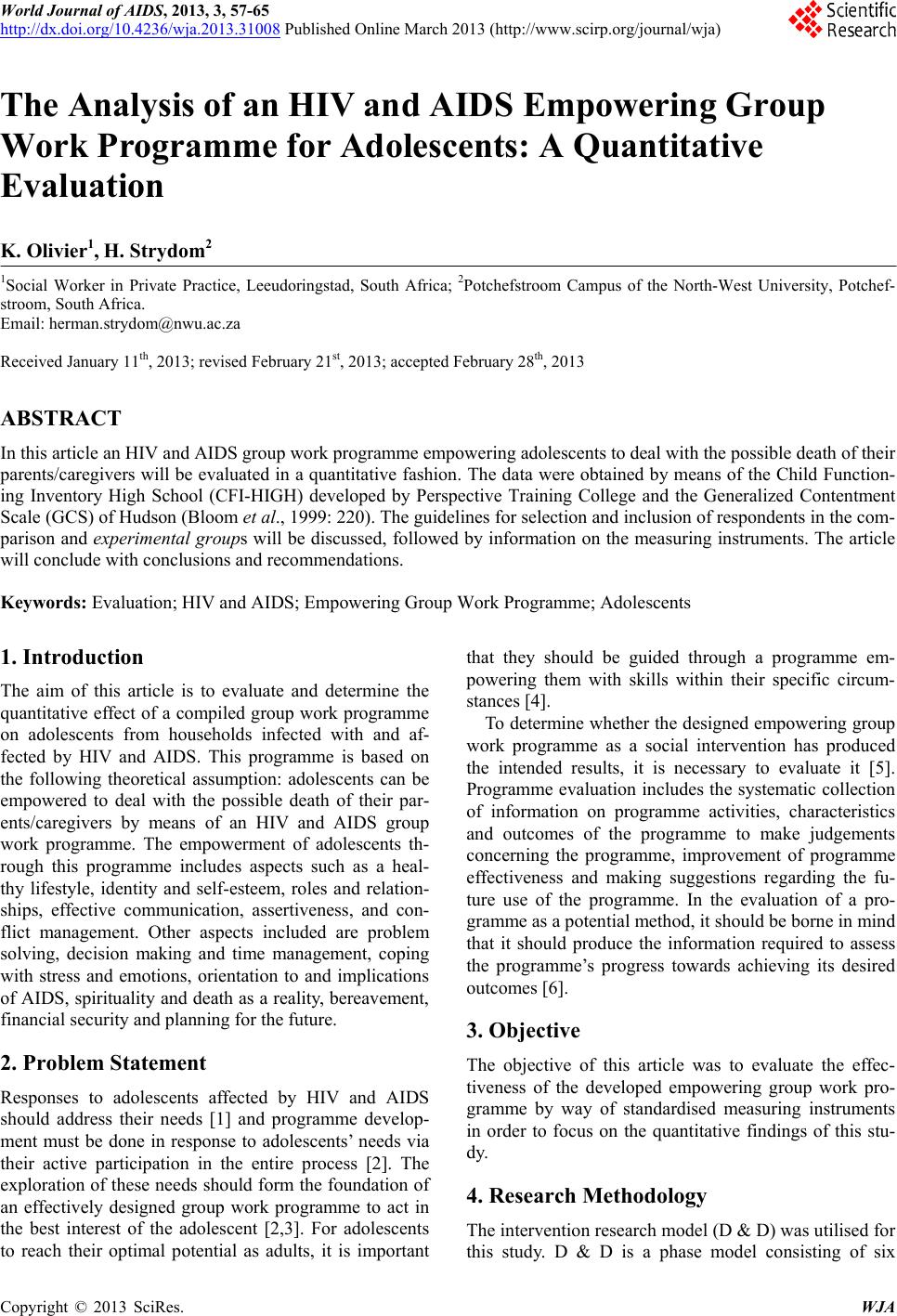 World Journal of AIDS, 2013, 3, 57-65 http://dx.doi.org/10.4236/wja.2013.31008 Published Online March 2013 (http://www.scirp.org/journal/wja) 57 The Analysis of an HIV and AIDS Empowering Group Work Programme for Adolescents: A Quantitative Evaluation K. Olivier1, H. Strydom2 1Social Worker in Private Practice, Leeudoringstad, South Africa; 2Potchefstroom Campus of the North-West University, Potchef- stroom, South Africa. Email: herman.strydom@nwu.ac.za Received January 11th, 2013; revised February 21st, 2013; accepted February 28th, 2013 ABSTRACT In this article an HIV and AIDS group work programme empowering adolescents to deal with the possible death of their parents/caregivers will be evaluated in a quantitative fashion. The data were obtained by means of the Child Function- ing Inventory High School (CFI-HIGH) developed by Perspective Training College and the Generalized Contentment Scale (GCS) of Hudson (Bloom et al., 1999: 220). The guidelines for selection and inclusion of respondents in the com- parison and experimental groups will be discussed, followed by information on the measuring instruments. The article will conclude with conclusions and recommendations. Keywords: Evaluation; HIV and AIDS; Empowering Group Work Programme; Adolescents 1. Introduction The aim of this article is to evaluate and determine the quantitative effect of a compiled group work programme on adolescents from households infected with and af- fected by HIV and AIDS. This programme is based on the following theoretical assumption: adolescents can be empowered to deal with the possible death of their par- ents/caregivers by means of an HIV and AIDS group work programme. The empowerment of adolescents th- rough this programme includes aspects such as a heal- thy lifestyle, identity and self-esteem, roles and relation- ships, effective communication, assertiveness, and con- flict management. Other aspects included are problem solving, decision making and time management, coping with stress and emotions, orientation to and implications of AIDS, spirituality and death as a reality, bereavement, financial security and planning for the future. 2. Problem Statement Responses to adolescents affected by HIV and AIDS should address their needs [1] and programme develop- ment must be done in response to adolescents’ needs via their active participation in the entire process [2]. The exploration of these needs should form the foundation of an effectively designed group work programme to act in the best interest of the adolescent [2,3]. For adolescents to reach their optimal potential as adults, it is important that they should be guided through a programme em- powering them with skills within their specific circum- stances [4]. To determine whether the designed empowering group work programme as a social intervention has produced the intended results, it is necessary to evaluate it [5]. Programme evaluation includes the systematic collection of information on programme activities, characteristics and outcomes of the programme to make judgements concerning the programme, improvement of programme effectiveness and making suggestions regarding the fu- ture use of the programme. In the evaluation of a pro- gramme as a potential method, it should be borne in mind that it should produce the information required to assess the programme’s progress towards achieving its desired outcomes [6]. 3. Objective The objective of this article was to evaluate the effec- tiveness of the developed empowering group work pro- gramme by way of standardised measuring instruments in order to focus on the quantitative findings of this stu- dy. 4. Research Methodology The intervention research model (D & D) was utilised for this study. D & D is a phase model consisting of six Copyright © 2013 SciRes. WJA  The Analysis of an HIV and AIDS Empowering Group Work Programme for Adolescents: A Quantitative Evaluation 58 phases [7]. The fifth phase of this model, namely evalua- tion and advanced development, was utilised. For the experiment the comparison group pretest-posttest design was utilized [8]. This design includes two groups, namely the experimental group and the comparison group. Ac- cording to this design only the experimental group re- ceived the programme, with the same before and after test for both groups, which were the Child Functioning Inventory High School (CFI-HIGH) [9] and the General- ized Contentment Scale (GCS) [10]. Although the assignment to the groups was done ran- domly as with the classic experimental design [11], the groups can never be exactly the same and therefore will be regarded as an experimental and comparative group [12]. The mentioned standardized measuring instruments were utilized in the process of the evaluation of the group work programme [13]. The aim of this experiment was to determine whether the application of an empowering group work programme had an influence on the adoles- cent’s functioning as part of a household infected with or affected by HIV and AIDS. A total of 24 adolescents were selected by means of accidental sampling [14]. Only 16 of these adolescents were available after the initial sampling to conduct this research. All of these 16 adolescents met the criteria for inclusion in the experiment, being adolescents (12 to 18 years) showing willingness to participate in the total pro- gramme and who are from households infected with or affected by HIV and AIDS where all of them had a parent or caretaker who is infected with HIV or is already ill due to AIDS or those adolescents who have already lost a parent(s) to AIDS. These 16 adolescents were then di- vided into 2 groups with age and gender as main criteria to have two as identical as possible groups. One group was then selected randomly as the comparison group and the other as the experi mental group. As ethical consideration, the comparison group was informed that they would be afforded the opportunity to undergo the same group work programme as the experi- mental group once the last-mentioned group had com- pleted it. This is to give all participants equal access to an empowering opportunity, namely that participation in a research project should be a learning experience for all concerned [15]. The quantitative data in this study was statistically computed with SAS [16]. The results were interpreted, inferences made and conclusions drawn. The practical significance of results is not only important when results of the population data are reported but also for com- menting on the practical significance of a statistically significant result [17]. 5. Evaluation by Means of Child Functioning Inventory High School (CFI-HIGH) The Child Functioning Inventory High School (CFI- HIGH) was administered in pre- and post-testing as part of the quantitative evaluation. The CFI-HIGH is a stan- dardized pen-and-paper self-reporting measuring instru- ment that can be utilized to evaluate the general func- tioning of children of high school age (adolescents) re- garding various aspects. The following areas of personal functioning are included: Positive functioning areas (in- cluding perseverance, satisfaction, future perspective), Self-perception (including anxiety, guilt feelings, lack of self-worth, isolation, responsibility for others, lack of assertiveness), Trauma dynamics (including memory loss, frustration, helplessness, attitude towards adults, mistrust, stigma, body image, personal boundaries, school prob- lems), Relationships (including relationship with friends, relationship with mother, relationship with father, rela- tionship with family), Decision making skills (including independency, responsibility). 5.1. Reliability of the CFI-HIGH The Cronbach Alpha coefficient is a criterion to deter- mine the internal consistency of a measuring instrument [18]. The reliability of the CFI-HIGH of Perspective was calculated with Cronbach Alfa coefficient. Huysamen [18] points out that a reliability coefficient as low as 0.6 can be considered acceptable for making decisions regarding groups. Four of the constructs were found to be not reli- able with reliability coefficients that were below 0.5. The constructs of the CFI-HIGH measuring anxiety, respon- sibility, relationships with friends and independency, can thus not be accepted as reliable. The constructs of the CFI-HIGH measuring perseverance, satisfaction, future perspective, guilt feelings, lack of self-worth, isolation, lack of assertiveness, memory loss, frustration, helpless- ness, attitude towards adults, mistrust, stigma, body im- age, personal boundaries, school problems, relationship with mother, relationship with father, relationship with family and responsibility were found to be reliable with reliability coefficients that varied between 0.57 and 0.90. 5.2. Pre- and Post-Testing Both the comparison and experimental groups were re- quested to complete the CFI-HIGH one week before the onset of the group work programme. After the pre-testing, only the experimental group was exposed to the group work programme consisting of 12 sessions presented over a period of six weeks. The post-test was conducted by requesting both the experimental and the comparison group to complete the CFI-HIGH once again. This post-testing took place one week after the experimental group had completed the group work programme. Be- cause of the small sample size, the tests might not have had enough power to indicate statistical significance on a 5% level of significance, and effect sizes will be used as an indication of the practical significance of differences. Copyright © 2013 SciRes. WJA  The Analysis of an HIV and AIDS Empowering Group Work Programme for Adolescents: A Quantitative Evaluation Copyright © 2013 SciRes. WJA 59 The results are expounded in Table 1. 5.3. Pre- and Post-Test Results 5.3.1. Res ults after Pre-Testing After pre-testing, the p-value (P) of the grouping of the experimental and comparison group regarding all the constructs measured >0.05. P-values > 0.05 indicate that the two groups did not differ statistically significantly on a 5% significance level at this point with regard to these constructs. The effect-size (D) of the test between groups (after pre-testing) regarding future perspective, guilt feelings, lack of self-worth, lack of assertiveness, mem- ory loss, helplessness, mistrust, stigma, relationship with father, relationship with family and responsibility were found to be >0.4, which indicates a medium visible and significant difference and an effect size >0.8 indicates that there is a large visibly to practically significant dif- ference between the two groups regarding these con- structs before the experimental group was exposed to the programme, with the experimental group being better. The effect-size (D) of the test between groups (after pre- testing) regarding isolation, frustration, attitude towards adults, body image, personal boundaries, school prob- lems and relationship with mother was found to be <0.4, which indicates an insignificant difference between the two groups regarding these constructs before the experi- mental group was exposed to the programme. 5.3.2. Res ults after Post-Tes t i n g Within experimental group After post-testing, the p-value (P) of the experimental gr oup regarding the constructs of satisfaction, guilt feelings Table 1. Results of pre- and post-testing of CFI-HIGH. Experimental group Comparison grou p Ancova Pre-Test Post-Test Test with in group Pre-Test Post-Test Test with in group Test between groups Average Standard deviation Aveage Standard deviation P D Average Standard deviation Average Standard deviation P D P-value Effect-size Perseverance 85.1 20.0 92.5 13.2 0.17050.3760.1 24.3 63.5 22.1 0.2849 0.14 0.0616−1.19 Satisfaction 74.3 17.9 87.4 12.3 0.00930.7357.9 20.6 55.O 19.6 0.2742 −0.14 0.00042.58 Future perspective 70.6 19.9 74.3 11.0 0.55570.1950.1 18.5 46.9 15.5 0.3566 −0.17 0.00941.74 Guilt feelings 28.8 25.7 18.0 17.9 0.0176−0.4242.0 22.3 42.8 17.3 0.7416 0.04 <0.0001 3.28 Lack of self-worth 19.1 15.9 9.9 9.6 0.0460−0.5836.3 22.1 34.5 24.4 0.5062 −0.08 0.06421.12 Isolation 43.6 20.5 40.1 15.5 0.3001−0.1741.3 20.1 41.4 22.2 0.9581 0.00 0.39830.45 Lack of assertiveness 29.4 22.9 19.8 20.6 0.0705−0.4240.4 23.3 41.1 22.6 0.7043 0.03 0.02711.27 Memory loss 23.9 28.5 13.9 18.5 0.1460−0.3535.9 22.8 39.9 24.9 0.2524 0.18 0.01601.39 Frustration 28.1 26.7 14.9 11.1 0.2003−0.4938.8 29.8 39.3 33.1 0.8679 0.02 0.06970.97 Helplessness 33.9 26.5 21.0 13.8 0.1038−0.4946.4 19.9 46.8 23.9 0.8904 0.02 0.01901.34 Attitude towards adults 23.5 26.6 15.3 12.6 0.2619−0.3133.6 21.8 35.4 19.2 0.4496 0.08 0.01051.48 Mistrust 45.4 12.7 32.5 7.1 0.0362−1.0253.4 7.4 51.0 9.5 0.1572 −0.32 0.00272.00 Stigma 44.5 26.6 31.6 18.5 0.0685−0.4857.8 17.1 60.5 15.7 0.2846 0.16 0.00211.95 Body image 26.3 29.2 14.4 18.9 0.0540−0.4132.4 25.6 33.1 25.9 0.1970 0.03 0.00581.66 Personal boundaries 32.3 25.1 12.5 6.2 0.0495−0.7934.4 16.0 41.8 18.2 0.1464 0.46 0.00052.33 School problems 27.9 27.9 11.4 13.5 0.0486−0.5928.9 24.5 33.2 27.1 0.1163 0.18 0.00461.61 Relationship with mother 74.6 26.4 80.5 16.6 0.46450.2266.0 29.0 59.3 26.5 0.0412 −0.23 0.03791.17 Relationship with father 58.5 25.4 63.1 28.2 0.27130.1840.9 23.6 41.0 23.0 0.9751 0.00 0.39300.48 Relationship with family 77.4 17.0 85.0 18.5 0.10170.4550.8 27.6 48.8 27.2 0.3699 −0.07 0.06041.18 Responsibility 71.3 19.6 83.5 18.7 0.02490.6259.8 24.2 59.8 23.1 1.0000 0.00 0.01311.50 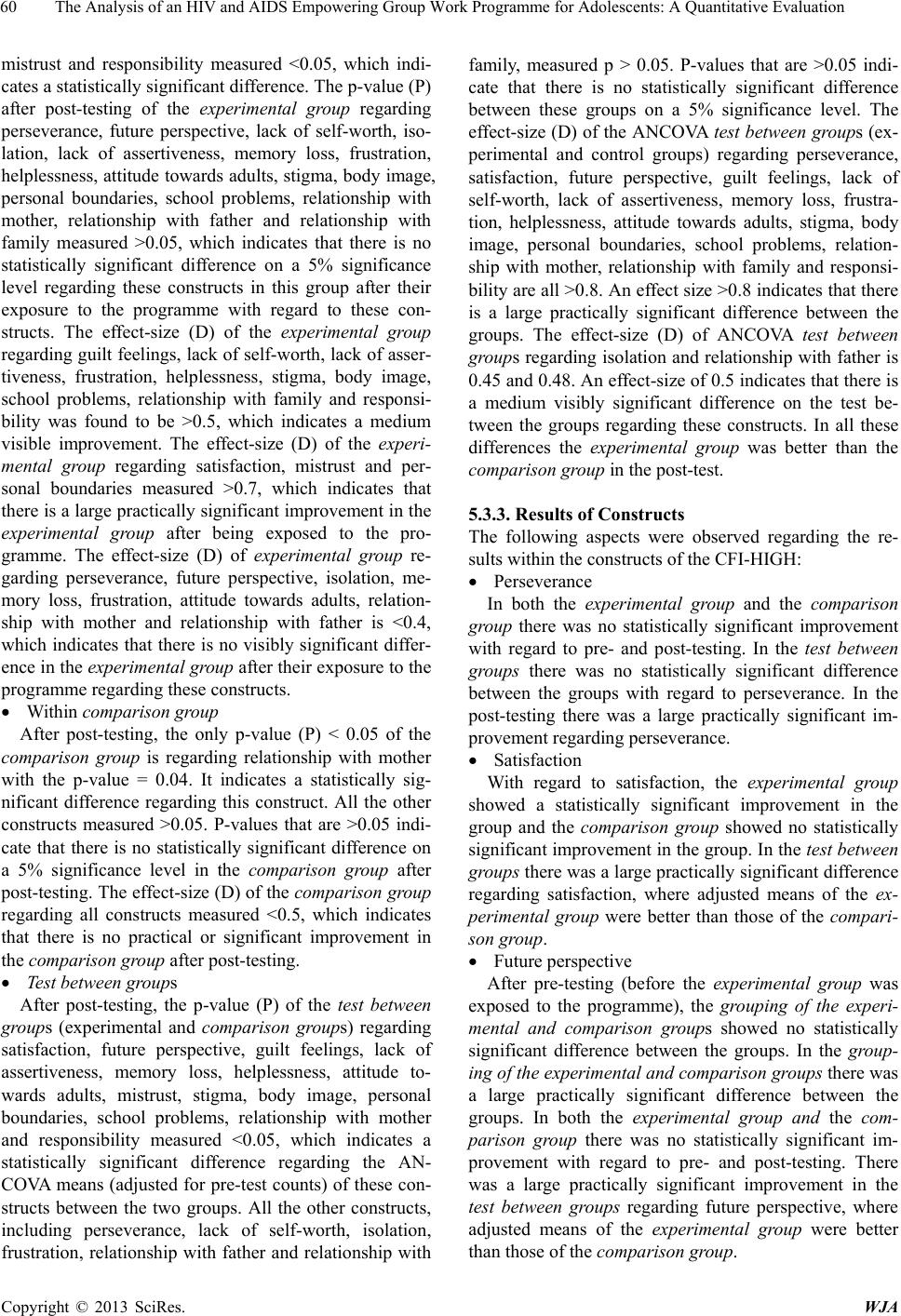 The Analysis of an HIV and AIDS Empowering Group Work Programme for Adolescents: A Quantitative Evaluation 60 mistrust and responsibility measured <0.05, which indi- cates a statistically significant difference. The p-value (P) after post-testing of the experimental group regarding perseverance, future perspective, lack of self-worth, iso- lation, lack of assertiveness, memory loss, frustration, helplessness, attitude towards adults, stigma, body image, personal boundaries, school problems, relationship with mother, relationship with father and relationship with family measured >0.05, which indicates that there is no statistically significant difference on a 5% significance level regarding these constructs in this group after their exposure to the programme with regard to these con- structs. The effect-size (D) of the experimental group regarding guilt feelings, lack of self-worth, lack of asser- tiveness, frustration, helplessness, stigma, body image, school problems, relationship with family and responsi- bility was found to be >0.5, which indicates a medium visible improvement. The effect-size (D) of the experi- mental group regarding satisfaction, mistrust and per- sonal boundaries measured >0.7, which indicates that there is a large practically significant improvement in the experimental group after being exposed to the pro- gramme. The effect-size (D) of experimental group re- garding perseverance, future perspective, isolation, me- mory loss, frustration, attitude towards adults, relation- ship with mother and relationship with father is <0.4, which indicates that there is no visibly significant differ- ence in the experimental group after their exposure to the programme regarding these constructs. Within comparison group After post-testing, the only p-value (P) < 0.05 of the comparison group is regarding relationship with mother with the p-value = 0.04. It indicates a statistically sig- nificant difference regarding this construct. All the other constructs measured >0.05. P-values that are >0.05 indi- cate that there is no statistically significant difference on a 5% significance level in the comparison group after post-testing. The effect-size (D) of the comparison group regarding all constructs measured <0.5, which indicates that there is no practical or significant improvement in the comparison group after post-testing. Test between groups After post-testing, the p-value (P) of the test between groups (experimental and comparison groups) regarding satisfaction, future perspective, guilt feelings, lack of assertiveness, memory loss, helplessness, attitude to- wards adults, mistrust, stigma, body image, personal boundaries, school problems, relationship with mother and responsibility measured <0.05, which indicates a statistically significant difference regarding the AN- COVA means (adjusted for pre-test counts) of these con- structs between the two groups. All the other constructs, including perseverance, lack of self-worth, isolation, frustration, relationship with father and relationship with family, measured p > 0.05. P-values that are >0.05 indi- cate that there is no statistically significant difference between these groups on a 5% significance level. The effect-size (D) of the ANCOVA test between groups (ex- perimental and control groups) regarding perseverance, satisfaction, future perspective, guilt feelings, lack of self-worth, lack of assertiveness, memory loss, frustra- tion, helplessness, attitude towards adults, stigma, body image, personal boundaries, school problems, relation- ship with mother, relationship with family and responsi- bility are all >0.8. An effect size >0.8 indicates that there is a large practically significant difference between the groups. The effect-size (D) of ANCOVA test between groups regarding isolation and relationship with father is 0.45 and 0.48. An effect-size of 0.5 indicates that there is a medium visibly significant difference on the test be- tween the groups regarding these constructs. In all these differences the experimental group was better than the comparison group in the post-test. 5.3.3. Res ults of Constructs The following aspects were observed regarding the re- sults within the constructs of the CFI-HIGH: Perseverance In both the experimental group and the comparison group there was no statistically significant improvement with regard to pre- and post-testing. In the test between groups there was no statistically significant difference between the groups with regard to perseverance. In the post-testing there was a large practically significant im- provement regarding perseverance. Satisfaction With regard to satisfaction, the experimental group showed a statistically significant improvement in the group and the comparison group showed no statistically significant improvement in the group. In the test b etween groups there was a large practically significant difference regarding satisfaction, where adjusted means of the ex- perimental group were better than those of the compari- son group. Future perspective After pre-testing (before the experimental group was exposed to the programme), the grouping of the experi- mental and comparison groups showed no statistically significant difference between the groups. In the group- ing of the experimental and comparison groups there was a large practically significant difference between the groups. In both the experimental group and the com- parison group there was no statistically significant im- provement with regard to pre- and post-testing. There was a large practically significant improvement in the test between groups regarding future perspective, where adjusted means of the experimental group were better than those of the comparison group. Copyright © 2013 SciRes. WJA 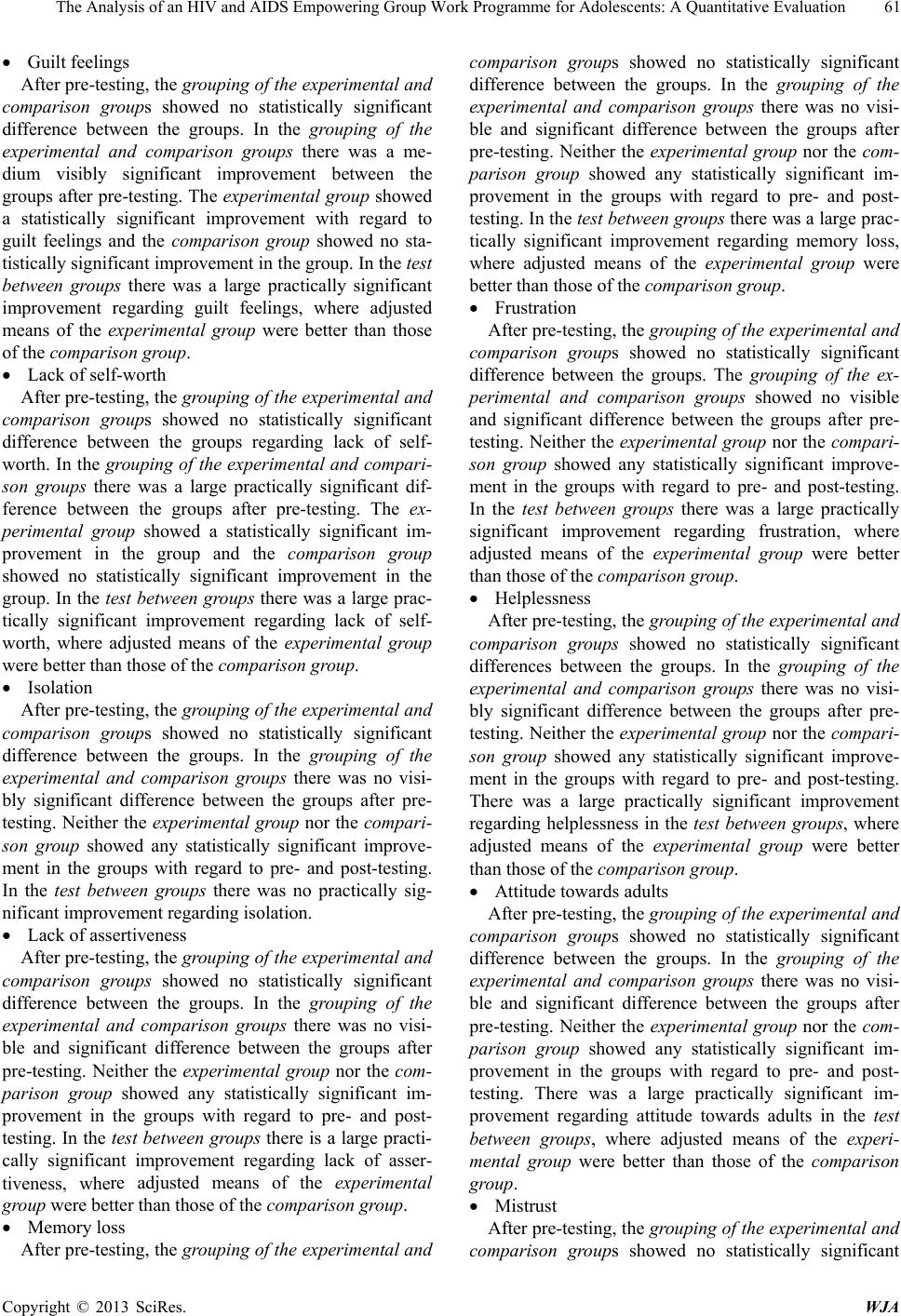 The Analysis of an HIV and AIDS Empowering Group Work Programme for Adolescents: A Quantitative Evaluation 61 Guilt feelings After pre-testing, the grouping of the experimental and comparison groups showed no statistically significant difference between the groups. In the grouping of the experimental and comparison groups there was a me- dium visibly significant improvement between the groups after pre-testing. The experimental group showed a statistically significant improvement with regard to guilt feelings and the comparison group showed no sta- tistically significant improvement in the group. In the test between groups there was a large practically significant improvement regarding guilt feelings, where adjusted means of the experimental group were better than those of the comparison group. Lack of self-worth After pre-testing, the grouping of the experimental and comparison groups showed no statistically significant difference between the groups regarding lack of self- worth. In the grouping of the experimental and compari- son groups there was a large practically significant dif- ference between the groups after pre-testing. The ex- perimental group showed a statistically significant im- provement in the group and the comparison group showed no statistically significant improvement in the group. In the test between groups there was a large prac- tically significant improvement regarding lack of self- worth, where adjusted means of the experimental group were better than those of the comparison group. Isolation After pre-testing, the grouping of the experimental and comparison groups showed no statistically significant difference between the groups. In the grouping of the experimental and comparison groups there was no visi- bly significant difference between the groups after pre- testing. Neither the experimental group nor the compari- son group showed any statistically significant improve- ment in the groups with regard to pre- and post-testing. In the test between groups there was no practically sig- nificant improvement regarding isolation. Lack of assertiveness After pre-testing, the grouping of the experimental and comparison groups showed no statistically significant difference between the groups. In the grouping of the experimental and comparison groups there was no visi- ble and significant difference between the groups after pre-testing. Neither the experimental group nor the com- parison group showed any statistically significant im- provement in the groups with regard to pre- and post- testing. In the test between groups there is a large practi- cally significant improvement regarding lack of asser- tiveness, where adjusted means of the experimental group were better than those of the comparison group. Memory loss After pre-testing, the grouping of the experimental and comparison groups showed no statistically significant difference between the groups. In the grouping of the experimental and comparison groups there was no visi- ble and significant difference between the groups after pre-testing. Neither the experimental group nor the com- parison group showed any statistically significant im- provement in the groups with regard to pre- and post- testing. In the test between groups there was a large prac- tically significant improvement regarding memory loss, where adjusted means of the experimental group were better than those of the comparison group . Frustration After pre-testing, the grouping of the experimental and comparison groups showed no statistically significant difference between the groups. The grouping of the ex- perimental and comparison groups showed no visible and significant difference between the groups after pre- testing. Neither the experimental group nor the compari- son group showed any statistically significant improve- ment in the groups with regard to pre- and post-testing. In the test between groups there was a large practically significant improvement regarding frustration, where adjusted means of the experimental group were better than those of the comparison group. Helplessness After pre-testing, the grouping of the experimental and comparison groups showed no statistically significant differences between the groups. In the grouping of the experimental and comparison groups there was no visi- bly significant difference between the groups after pre- testing. Neither the experimental group nor the compari- son group showed any statistically significant improve- ment in the groups with regard to pre- and post-testing. There was a large practically significant improvement regarding helplessness in the test between groups, where adjusted means of the experimental group were better than those of the comparison group. Attitude towards adults After pre-testing, the grouping of the experimental and comparison groups showed no statistically significant difference between the groups. In the grouping of the experimental and comparison groups there was no visi- ble and significant difference between the groups after pre-testing. Neither the experimental group nor the com- parison group showed any statistically significant im- provement in the groups with regard to pre- and post- testing. There was a large practically significant im- provement regarding attitude towards adults in the test between groups, where adjusted means of the experi- mental group were better than those of the comparison group. Mistrust After pre-testing, the grouping of the experimental and comparison groups showed no statistically significant Copyright © 2013 SciRes. WJA 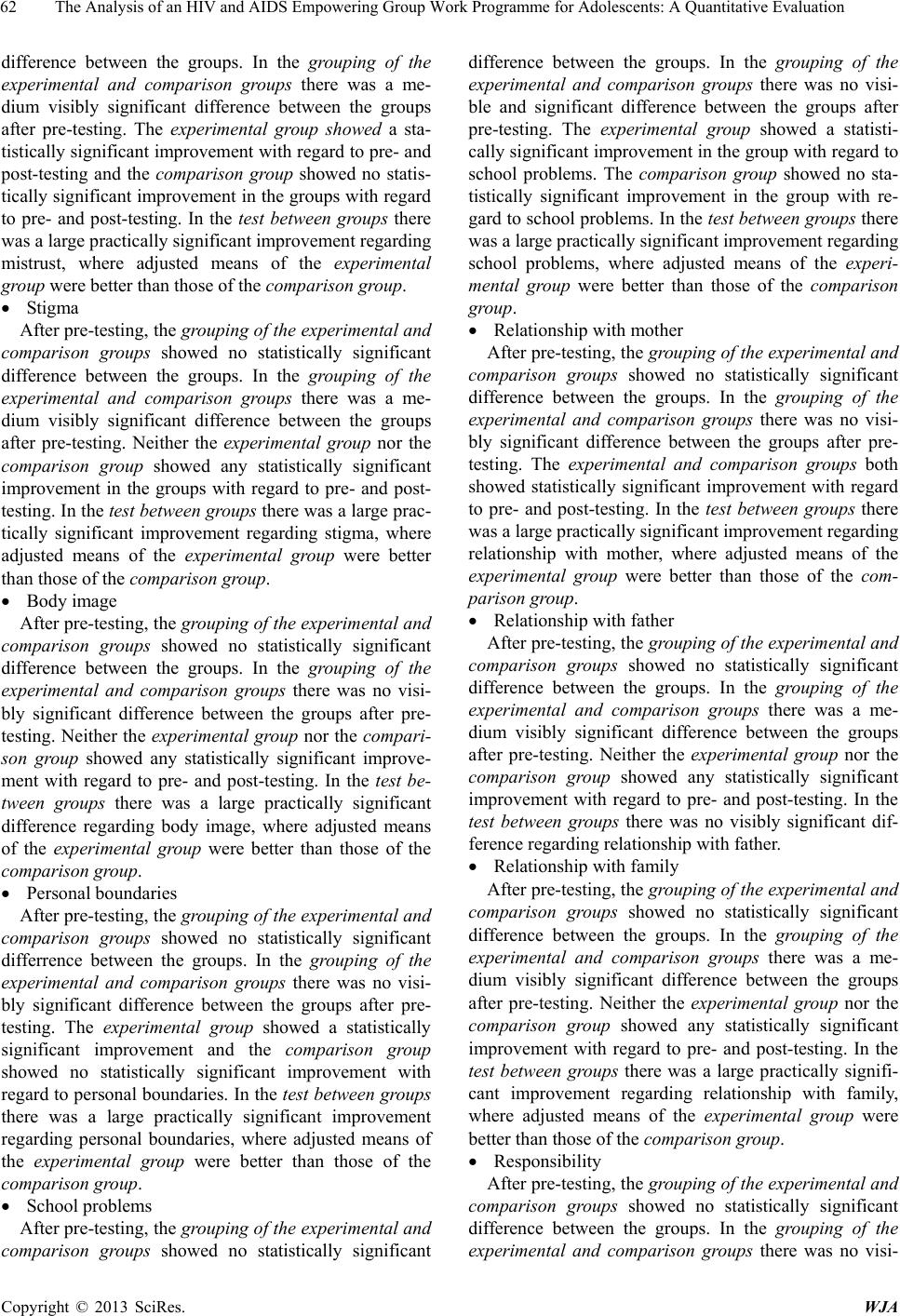 The Analysis of an HIV and AIDS Empowering Group Work Programme for Adolescents: A Quantitative Evaluation 62 difference between the groups. In the grouping of the experimental and comparison groups there was a me- dium visibly significant difference between the groups after pre-testing. The experimental group showed a sta- tistically significant improvement with regard to pre- and post-testing and the comparison group showed no statis- tically significant improvement in the groups with regard to pre- and post-testing. In the test between groups there was a large practically significant improvement regarding mistrust, where adjusted means of the experimental group were better than those of the comparison group. Stigma After pre-testing, the grouping of the experimental and comparison groups showed no statistically significant difference between the groups. In the grouping of the experimental and comparison groups there was a me- dium visibly significant difference between the groups after pre-testing. Neither the experimental group nor the comparison group showed any statistically significant improvement in the groups with regard to pre- and post- testing. In the test between groups there was a large prac- tically significant improvement regarding stigma, where adjusted means of the experimental group were better than those of the comparison group. Body image After pre-testing, the grouping of the experimental and comparison groups showed no statistically significant difference between the groups. In the grouping of the experimental and comparison groups there was no visi- bly significant difference between the groups after pre- testing. Neither the experimental group nor the compari- son group showed any statistically significant improve- ment with regard to pre- and post-testing. In the test be- tween groups there was a large practically significant difference regarding body image, where adjusted means of the experimental group were better than those of the comparison group. Personal boundaries After pre-testing, the grouping of the experimental and comparison groups showed no statistically significant differrence between the groups. In the grouping of the experimental and comparison groups there was no visi- bly significant difference between the groups after pre- testing. The experimental group showed a statistically significant improvement and the comparison group showed no statistically significant improvement with regard to personal boundaries. In the test between groups there was a large practically significant improvement regarding personal boundaries, where adjusted means of the experimental group were better than those of the comparison group. School problems After pre-testing, the grouping of the experimental and comparison groups showed no statistically significant difference between the groups. In the grouping of the experimental and comparison groups there was no visi- ble and significant difference between the groups after pre-testing. The experimental group showed a statisti- cally significant improvement in the group with regard to school problems. The comparison group showed no sta- tistically significant improvement in the group with re- gard to school problems. In the test between groups there was a large practically significant improvement regarding school problems, where adjusted means of the experi- mental group were better than those of the comparison group. Relationship with mother After pre-testing, the grouping of the experimental and comparison groups showed no statistically significant difference between the groups. In the grouping of the experimental and comparison groups there was no visi- bly significant difference between the groups after pre- testing. The experimental and comparison groups both showed statistically significant improvement with regard to pre- and post-testing. In the test between groups there was a large practically significant improvement regarding relationship with mother, where adjusted means of the experimental group were better than those of the com- parison group. Relationship with father After pre-testing, the grouping of the experimental and comparison groups showed no statistically significant difference between the groups. In the grouping of the experimental and comparison groups there was a me- dium visibly significant difference between the groups after pre-testing. Neither the experimental group nor the comparison group showed any statistically significant improvement with regard to pre- and post-testing. In the test between groups there was no visibly significant dif- ference regarding relationship with father. Relationship with family After pre-testing, the grouping of the experimental and comparison groups showed no statistically significant difference between the groups. In the grouping of the experimental and comparison groups there was a me- dium visibly significant difference between the groups after pre-testing. Neither the experimental group nor the comparison group showed any statistically significant improvement with regard to pre- and post-testing. In the test between groups there was a large practically signifi- cant improvement regarding relationship with family, where adjusted means of the experimental group were better than those of the comparison group . Responsibility After pre-testing, the grouping of the experimental and comparison groups showed no statistically significant difference between the groups. In the grouping of the experimental and comparison groups there was no visi- Copyright © 2013 SciRes. WJA 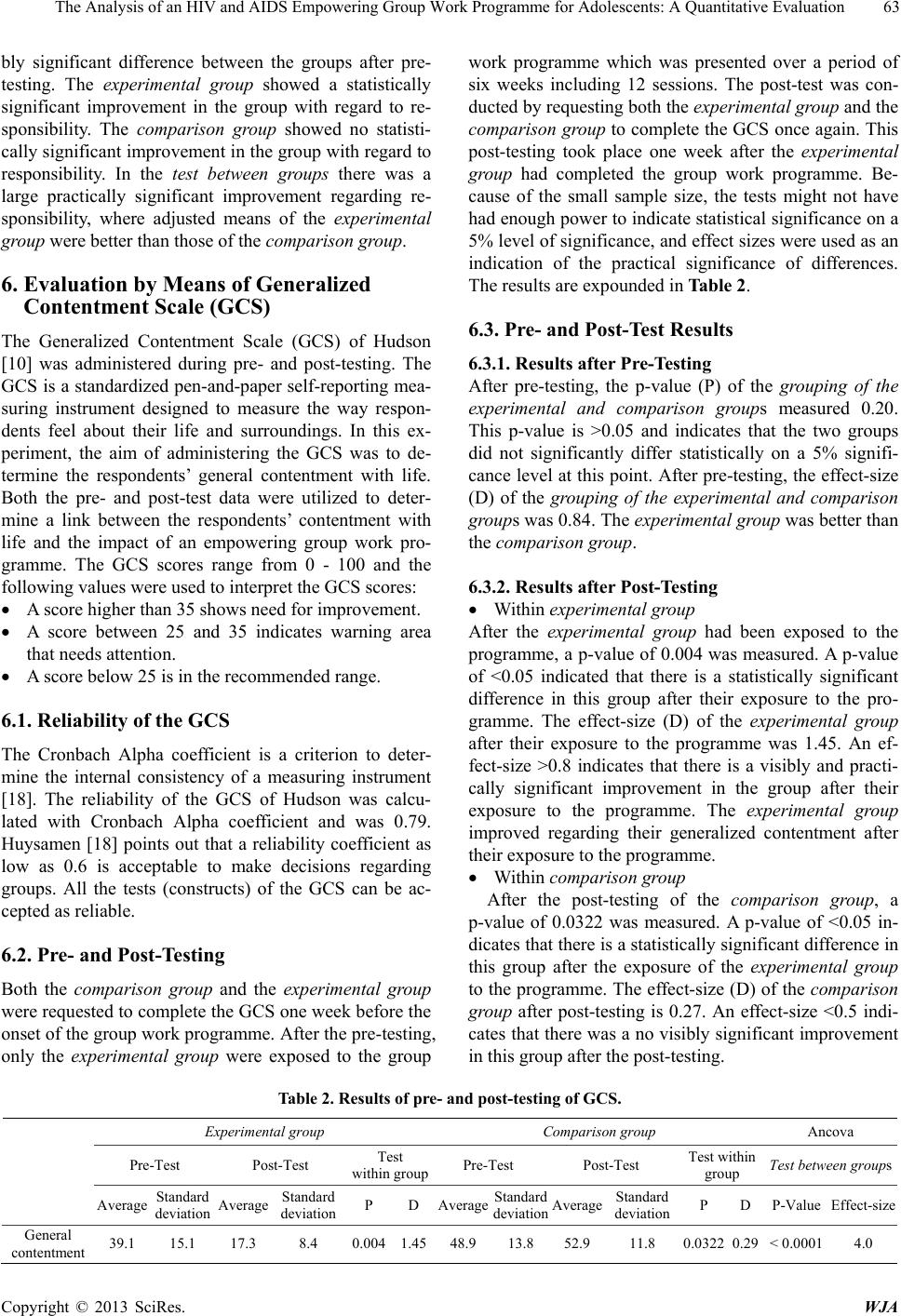 The Analysis of an HIV and AIDS Empowering Group Work Programme for Adolescents: A Quantitative Evaluation Copyright © 2013 SciRes. WJA 63 bly significant difference between the groups after pre- testing. The experimental group showed a statistically significant improvement in the group with regard to re- sponsibility. The comparison group showed no statisti- cally significant improvement in the group with regard to responsibility. In the test between groups there was a large practically significant improvement regarding re- sponsibility, where adjusted means of the experimental group were better than those of the comparison group. 6. Evaluation by Means of Generalized Contentment Scale (GCS) The Generalized Contentment Scale (GCS) of Hudson [10] was administered during pre- and post-testing. The GCS is a standardized pen-and-paper self-reporting mea- suring instrument designed to measure the way respon- dents feel about their life and surroundings. In this ex- periment, the aim of administering the GCS was to de- termine the respondents’ general contentment with life. Both the pre- and post-test data were utilized to deter- mine a link between the respondents’ contentment with life and the impact of an empowering group work pro- gramme. The GCS scores range from 0 - 100 and the following values were used to interpret the GCS scores: A score higher than 35 shows need for improvement. A score between 25 and 35 indicates warning area that needs attention. A score below 25 is in the recommended range. 6.1. Reliability of the GCS The Cronbach Alpha coefficient is a criterion to deter- mine the internal consistency of a measuring instrument [18]. The reliability of the GCS of Hudson was calcu- lated with Cronbach Alpha coefficient and was 0.79. Huysamen [18] points out that a reliability coefficient as low as 0.6 is acceptable to make decisions regarding groups. All the tests (constructs) of the GCS can be ac- cepted as reliable. 6.2. Pre- and Post-Testing Both the comparison group and the experimental group were requested to complete the GCS one week before the onset of the group work programme. After the pre-testing, only the experimental group were exposed to the group work programme which was presented over a period of six weeks including 12 sessions. The post-test was con- ducted by requesting both the experimental group and the comparison group to complete the GCS once again. This post-testing took place one week after the experimental group had completed the group work programme. Be- cause of the small sample size, the tests might not have had enough power to indicate statistical significance on a 5% level of significance, and effect sizes were used as an indication of the practical significance of differences. The results are expounded in Table 2. 6.3. Pre- and Post-Test Results 6.3.1. Res ults after Pre-Testing After pre-testing, the p-value (P) of the grouping of the experimental and comparison groups measured 0.20. This p-value is >0.05 and indicates that the two groups did not significantly differ statistically on a 5% signifi- cance level at this point. After pre-testing, the effect-size (D) of the grouping of the experimental and comparison groups was 0.84. The experimental group was better than the comparison group. 6.3.2. Re su lts after Post-Tes t i n g Within experimental group After the experimental group had been exposed to the programme, a p-value of 0.004 was measured. A p-value of <0.05 indicated that there is a statistically significant difference in this group after their exposure to the pro- gramme. The effect-size (D) of the experimental group after their exposure to the programme was 1.45. An ef- fect-size >0.8 indicates that there is a visibly and practi- cally significant improvement in the group after their exposure to the programme. The experimental group improved regarding their generalized contentment after their exposure to the programme. Within comparison group After the post-testing of the comparison group, a p-value of 0.0322 was measured. A p-value of <0.05 in- dicates that there is a statistically significant difference in this group after the exposure of the experimental group to the programme. The effect-size (D) of the comparison group after post-testing is 0.27. An effect-size <0.5 indi- cates that there was a no visibly significant improvement in this group after the post-testing. Table 2. Results of pre- and post-testing of GCS. Experimental group Comparison grou p Ancova Pre-Test Post-Test Test within groupPre-Test Post-Test Test within group Test between groups Average Standard deviation Average Standard deviation P D Average Standard deviation Average Standard deviation P D P-Value Effect-size General contentment 39.1 15.1 17.3 8.4 0.0041.4548.9 13.8 52.911.8 0.0322 0.29 < 0.00014.0 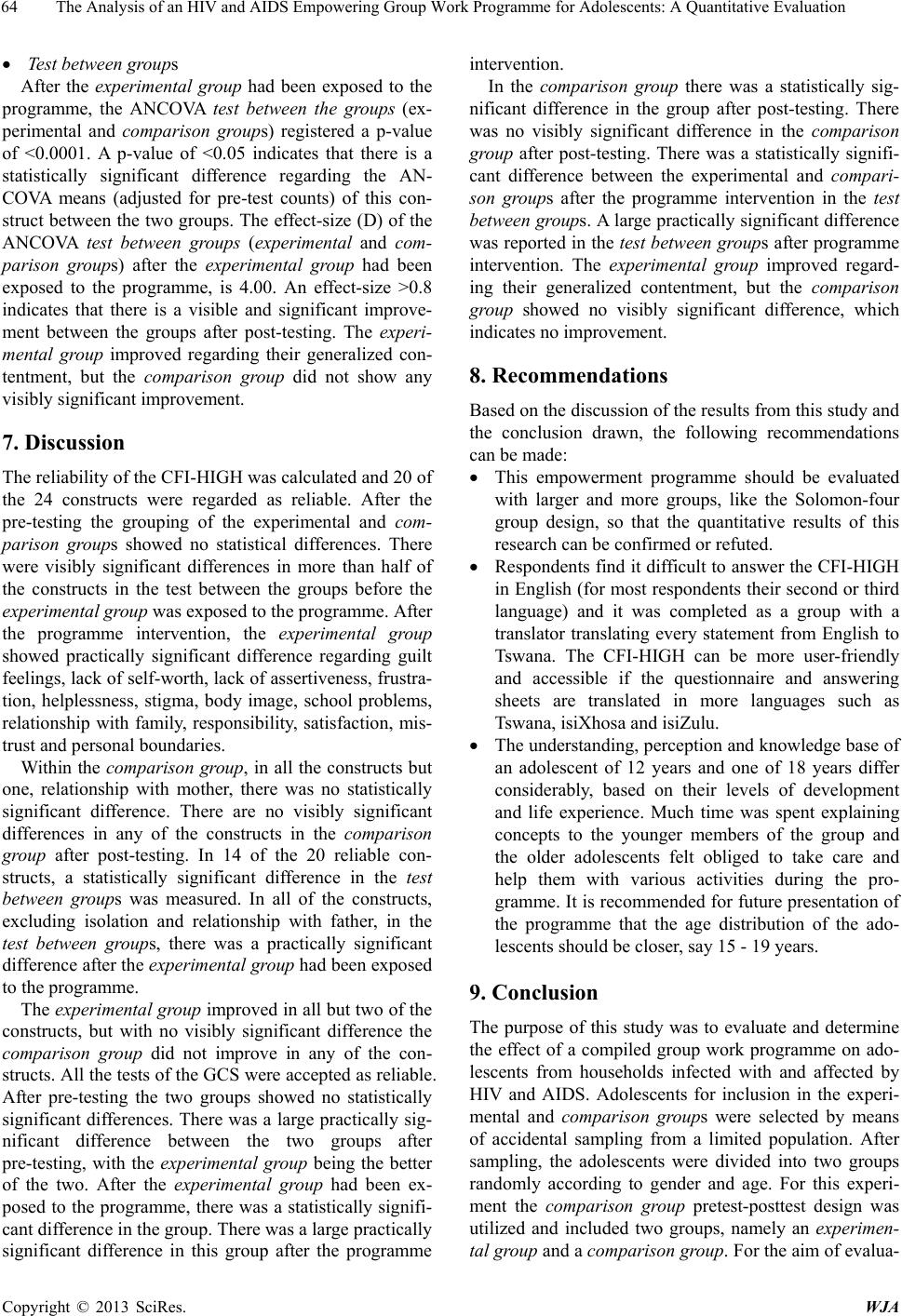 The Analysis of an HIV and AIDS Empowering Group Work Programme for Adolescents: A Quantitative Evaluation 64 Test between groups After the experimental group had been exposed to the programme, the ANCOVA test between the groups (ex- perimental and comparison groups) registered a p-value of <0.0001. A p-value of <0.05 indicates that there is a statistically significant difference regarding the AN- COVA means (adjusted for pre-test counts) of this con- struct between the two groups. The effect-size (D) of the ANCOVA test between groups (experimental and com- parison groups) after the experimental group had been exposed to the programme, is 4.00. An effect-size >0.8 indicates that there is a visible and significant improve- ment between the groups after post-testing. The experi- mental group improved regarding their generalized con- tentment, but the comparison group did not show any visibly significant improvement. 7. Discussion The reliability of the CFI-HIGH was calculated and 20 of the 24 constructs were regarded as reliable. After the pre-testing the grouping of the experimental and com- parison groups showed no statistical differences. There were visibly significant differences in more than half of the constructs in the test between the groups before the experimental group was exposed to the programme. After the programme intervention, the experimental group showed practically significant difference regarding guilt feelings, lack of self-worth, lack of assertiveness, frustra- tion, helplessness, stigma, body image, school problems, relationship with family, responsibility, satisfaction, mis- trust and personal boundaries. Within the comparison group, in all the constructs but one, relationship with mother, there was no statistically significant difference. There are no visibly significant differences in any of the constructs in the comparison group after post-testing. In 14 of the 20 reliable con- structs, a statistically significant difference in the test between groups was measured. In all of the constructs, excluding isolation and relationship with father, in the test between groups, there was a practically significant difference after the exp erimental group had been exposed to the programme. The experimental group improved in all but two of the constructs, but with no visibly significant difference the comparison group did not improve in any of the con- structs. All the tests of the GCS were accepted as reliable. After pre-testing the two groups showed no statistically significant differences. There was a large practically sig- nificant difference between the two groups after pre-testing, with the experimental group being the better of the two. After the experimental group had been ex- posed to the programme, there was a statistically signifi- cant difference in the group. There was a large practically significant difference in this group after the programme intervention. In the comparison group there was a statistically sig- nificant difference in the group after post-testing. There was no visibly significant difference in the comparison group after post-testing. There was a statistically signifi- cant difference between the experimental and compari- son groups after the programme intervention in the test between groups. A large practically significant difference was reported in the test between groups after programme intervention. The experimental group improved regard- ing their generalized contentment, but the comparison group showed no visibly significant difference, which indicates no improvement. 8. Recommendations Based on the discussion of the results from this study and the conclusion drawn, the following recommendations can be made: This empowerment programme should be evaluated with larger and more groups, like the Solomon-four group design, so that the quantitative results of this research can be confirmed or refuted. Respondents find it difficult to answer the CFI-HIGH in English (for most respondents their second or third language) and it was completed as a group with a translator translating every statement from English to Tswana. The CFI-HIGH can be more user-friendly and accessible if the questionnaire and answering sheets are translated in more languages such as Tswana, isiXhosa and isiZulu. The understanding, perception and knowledge base of an adolescent of 12 years and one of 18 years differ considerably, based on their levels of development and life experience. Much time was spent explaining concepts to the younger members of the group and the older adolescents felt obliged to take care and help them with various activities during the pro- gramme. It is recommended for future presentation of the programme that the age distribution of the ado- lescents should be closer, say 15 - 19 years. 9. Conclusion The purpose of this study was to evaluate and determine the effect of a compiled group work programme on ado- lescents from households infected with and affected by HIV and AIDS. Adolescents for inclusion in the experi- mental and comparison groups were selected by means of accidental sampling from a limited population. After sampling, the adolescents were divided into two groups randomly according to gender and age. For this experi- ment the comparison group pretest-posttest design was utilized and included two groups, namely an experimen- tal group and a comparison group. For the aim of evalua- Copyright © 2013 SciRes. WJA 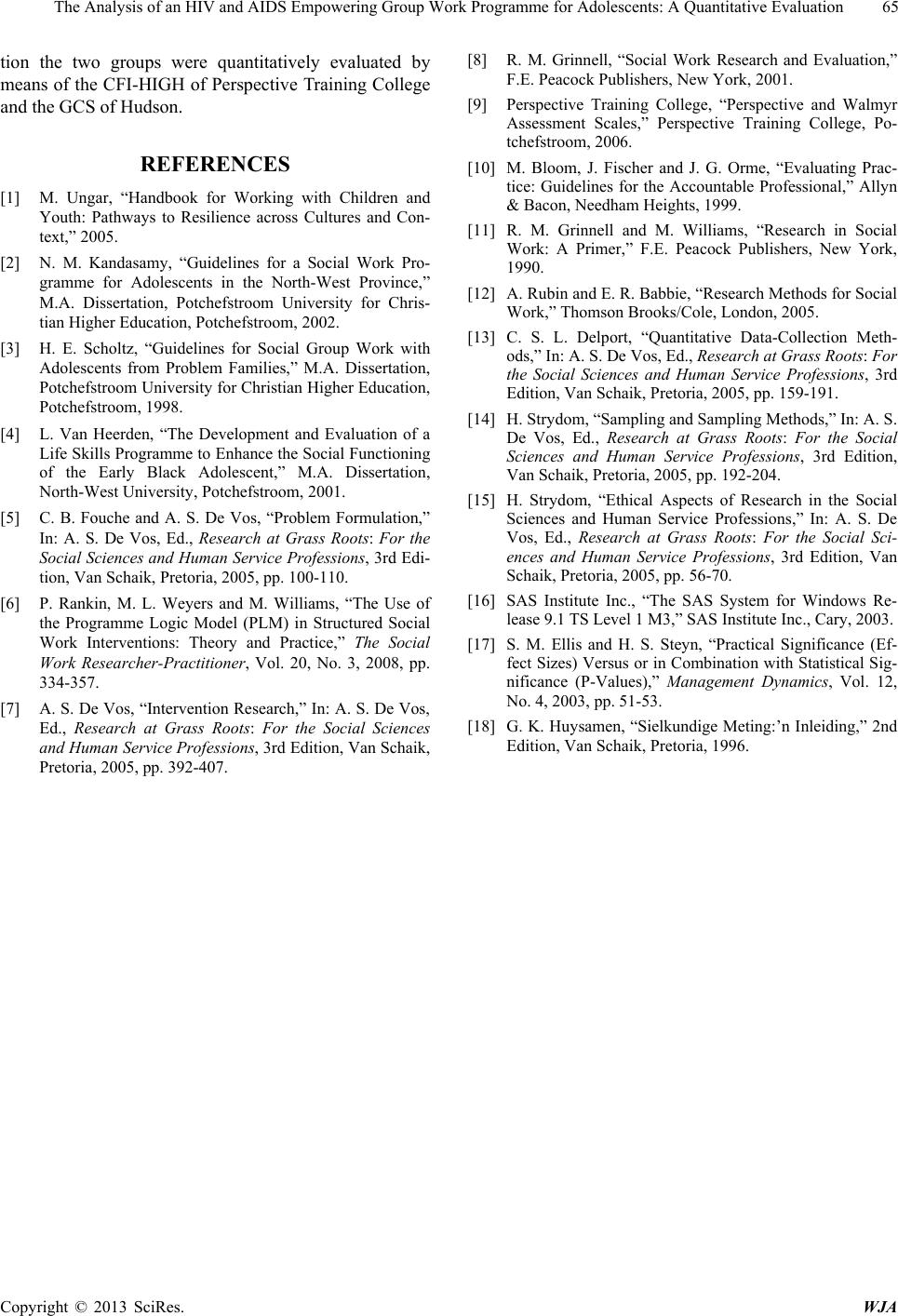 The Analysis of an HIV and AIDS Empowering Group Work Programme for Adolescents: A Quantitative Evaluation 65 tion the two groups were quantitatively evaluated by means of the CFI-HIGH of Perspective Training College and the GCS of Hudson. REFERENCES [1] M. Ungar, “Handbook for Working with Children and Youth: Pathways to Resilience across Cultures and Con- text,” 2005. [2] N. M. Kandasamy, “Guidelines for a Social Work Pro- gramme for Adolescents in the North-West Province,” M.A. Dissertation, Potchefstroom University for Chris- tian Higher Education, Potchefstroom, 2002. [3] H. E. Scholtz, “Guidelines for Social Group Work with Adolescents from Problem Families,” M.A. Dissertation, Potchefstroom University for Christian Higher Education, Potchefstroom, 1998. [4] L. Van Heerden, “The Development and Evaluation of a Life Skills Programme to Enhance the Social Functioning of the Early Black Adolescent,” M.A. Dissertation, North-West University, Potchefstroom, 2001. [5] C. B. Fouche and A. S. De Vos, “Problem Formulation,” In: A. S. De Vos, Ed., Research at Grass Roots: For the Social Sciences and Human Service Professions, 3rd Edi- tion, Van Schaik, Pretoria, 2005, pp. 100-110. [6] P. Rankin, M. L. Weyers and M. Williams, “The Use of the Programme Logic Model (PLM) in Structured Social Work Interventions: Theory and Practice,” The Social Work Researcher-Practitioner, Vol. 20, No. 3, 2008, pp. 334-357. [7] A. S. De Vos, “Intervention Research,” In: A. S. De Vos, Ed., Research at Grass Roots: For the Social Sciences and Human Service Professions, 3rd Edition, Van Schaik, Pretoria, 2005, pp. 392-407. [8] R. M. Grinnell, “Social Work Research and Evaluation,” F.E. Peacock Publishers, New York, 2001. [9] Perspective Training College, “Perspective and Walmyr Assessment Scales,” Perspective Training College, Po- tchefstroom, 2006. [10] M. Bloom, J. Fischer and J. G. Orme, “Evaluating Prac- tice: Guidelines for the Accountable Professional,” Allyn & Bacon, Needham Heights, 1999. [11] R. M. Grinnell and M. Williams, “Research in Social Work: A Primer,” F.E. Peacock Publishers, New York, 1990. [12] A. Rubin and E. R. Babbie, “Research Methods for Social Work,” Thomson Brooks/Cole, London, 2005. [13] C. S. L. Delport, “Quantitative Data-Collection Meth- ods,” In: A. S. De Vos, Ed., Research at Grass Roots: For the Social Sciences and Human Service Professions, 3rd Edition, Van Schaik, Pretoria, 2005, pp. 159-191. [14] H. Strydom, “Sampling and Sampling Methods,” In: A. S. De Vos, Ed., Research at Grass Roots: For the Social Sciences and Human Service Professions, 3rd Edition, Van Schaik, Pretoria, 2005, pp. 192-204. [15] H. Strydom, “Ethical Aspects of Research in the Social Sciences and Human Service Professions,” In: A. S. De Vos, Ed., Research at Grass Roots: For the Social Sci- ences and Human Service Professions, 3rd Edition, Van Schaik, Pretoria, 2005, pp. 56-70. [16] SAS Institute Inc., “The SAS System for Windows Re- lease 9.1 TS Level 1 M3,” SAS Institute Inc., Cary, 2003. [17] S. M. Ellis and H. S. Steyn, “Practical Significance (Ef- fect Sizes) Versus or in Combination with Statistical Sig- nificance (P-Values),” Management Dynamics, Vol. 12, No. 4, 2003, pp. 51-53. [18] G. K. Huysamen, “Sielkundige Meting:’n Inleiding,” 2nd Edition, Van Schaik, Pretoria, 1996. Copyright © 2013 SciRes. WJA |

